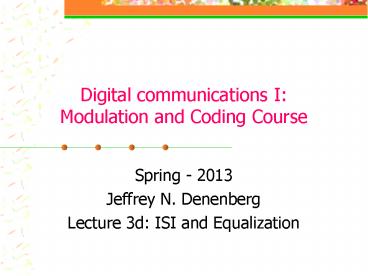Digital communications I: Modulation and Coding Course - PowerPoint PPT Presentation
Title:
Digital communications I: Modulation and Coding Course
Description:
Title: Modulation, Demodulation and Coding Course Author: sf Last modified by: Jeff Created Date: 1/1/1601 12:00:00 AM Document presentation format – PowerPoint PPT presentation
Number of Views:477
Avg rating:3.0/5.0
Title: Digital communications I: Modulation and Coding Course
1
Digital communications IModulation and Coding
Course
- Spring - 2013
- Jeffrey N. Denenberg
- Lecture 3d ISI and Equalization
2
Last time we talked about
- Signal detection in AWGN channels
- Minimum distance detector
- Maximum likelihood
- Average probability of symbol error
- Union bound on error probability
- Upper bound on error probability based on the
minimum distance
3
Today we are going to talk about
- Another source of error
- Inter-symbol interference (ISI)
- Nyquist theorem
- The techniques to reduce ISI
- Pulse shaping
- Equalization
4
Inter-Symbol Interference (ISI)
- ISI in the detection process due to the filtering
effects of the system - Overall equivalent system transfer function
- creates echoes and hence time dispersion
- causes ISI at sampling time
5
Inter-symbol interference
- Baseband system model
- Equivalent model
6
Nyquist bandwidth constraint
- Nyquist bandwidth constraint
- The theoretical minimum required system bandwidth
to detect Rs symbols/s without ISI is Rs/2
Hz. - Equivalently, a system with bandwidth W1/2TRs/2
Hz can support a maximum transmission rate of
2W1/TRs symbols/s without ISI. - Bandwidth efficiency, R/W bits/s/Hz
- An important measure in DCs representing data
throughput per hertz of bandwidth. - Showing how efficiently the bandwidth resources
are used by signaling techniques.
7
Ideal Nyquist pulse (filter)
Ideal Nyquist filter
Ideal Nyquist pulse
8
Nyquist pulses (filters)
- Nyquist pulses (filters)
- Pulses (filters) which results in no ISI at the
sampling time. - Nyquist filter
- Its transfer function in frequency domain is
obtained by convolving a rectangular function
with any real even-symmetric frequency function - Nyquist pulse
- Its shape can be represented by a sinc(t/T)
function multiply by another time function. - Example of Nyquist filters Raised-Cosine filter
9
Pulse shaping to reduce ISI
- Goals and trade-off in pulse-shaping
- Reduce ISI
- Efficient bandwidth utilization
- Robustness to timing error (small side lobes)
10
The raised cosine filter
- Raised-Cosine Filter
- A Nyquist pulse (No ISI at the sampling time)
Roll-off factor
Excess bandwidth
11
The Raised cosine filter contd
1
1
0.5
0.5
0
0
12
Pulse shaping and equalization to remove ISI
No ISI at the sampling time
- Square-Root Raised Cosine (SRRC) filter and
Equalizer
Taking care of ISI caused by channel
13
Example of pulse shaping
- Square-root Raised-Cosine (SRRC) pulse shaping
Amp. V
Baseband tr. Waveform
Third pulse
t/T
First pulse
Second pulse
Data symbol
14
Example of pulse shaping
- Raised Cosine pulse at the output of matched
filter
Amp. V
Baseband received waveform at the matched filter
output (zero ISI)
t/T
15
Eye pattern
- Eye patternDisplay on an oscilloscope which
sweeps the system response to a baseband signal
at the rate 1/T (T symbol duration)
Distortion due to ISI
Noise margin
amplitude scale
Sensitivity to timing error
Timing jitter
time scale
16
Example of eye patternBinary-PAM, SRRQ pulse
- Perfect channel (no noise and no ISI)
17
Example of eye patternBinary-PAM, SRRQ pulse
- AWGN (Eb/N020 dB) and no ISI
18
Example of eye patternBinary-PAM, SRRQ pulse
- AWGN (Eb/N010 dB) and no ISI
19
Equalization contd
Step 1 waveform to sample transformation
Step 2 decision making
Demodulate Sample
Detect
Threshold comparison
Frequency down-conversion
Receiving filter
Equalizing filter
Compensation for channel induced ISI
For bandpass signals
Baseband pulse (possibly distored)
Received waveform
Sample (test statistic)
Baseband pulse
20
Equalization
- ISI due to filtering effect of the communications
channel (e.g. wireless channels) - Channels behave like band-limited filters
Non-constant amplitude Amplitude distortion
Non-linear phase Phase distortion
21
Equalization Channel examples
- Example of a frequency selective, slowly changing
(slow fading) channel for a user at 35 km/h
22
Equalization Channel examples
- Example of a frequency selective, fast changing
(fast fading) channel for a user at 35 km/h
23
Example of eye pattern with ISIBinary-PAM, SRRQ
pulse
- Non-ideal channel and no noise
24
Example of eye pattern with ISIBinary-PAM, SRRQ
pulse
- AWGN (Eb/N020 dB) and ISI
25
Example of eye pattern with ISIBinary-PAM, SRRQ
pulse
- AWGN (Eb/N010 dB) and ISI
26
Equalizing filters
- Baseband system model
- Equivalent model
Tx filter
Channel
Rx. filter
Detector
Equalizer
Equivalent system
Detector
Equalizer
filtered noise
27
Equalization contd
- Equalization using
- MLSE (Maximum likelihood sequence estimation)
- Filtering See notes on z-Transform and Digital
Filters - Transversal filtering
- Zero-forcing equalizer
- Minimum mean square error (MSE) equalizer
- Decision feedback
- Using the past decisions to remove the ISI
contributed by them - Adaptive equalizer
28
Equalization by transversal filtering
- Transversal filter
- A weighted tap delayed line that reduces the
effect of ISI by proper adjustment of the filter
taps.
Coeff. adjustment
29
Transversal equalizing filter
- Zero-forcing equalizer
- The filter taps are adjusted such that the
equalizer output is forced to be zero at N sample
points on each side - Mean Square Error (MSE) equalizer
- The filter taps are adjusted such that the MSE of
ISI and noise power at the equalizer output is
minimized.
Adjust
Adjust
30
Example of equalizer
Matched filter outputs at the sampling time
- 2-PAM with SRRQ
- Non-ideal channel
- One-tap DFE
ISI-no noise, No equalizer
ISI-no noise, DFE equalizer
ISI- noise No equalizer
ISI- noise DFE equalizer































